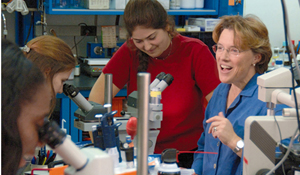Neuroscience Faculty Awarded $2.6 Million in Grants

For Immediate Release
Neuroscience Faculty Members Awarded Grants Totaling $2.6 Million in 2011
—Grants enable unparalleled research opportunities for Wellesley undergraduates—
WELLESLEY, Mass.—February 3, 2011—Different sensory features are recognized by separate parts of the brain. One part of the brain might distinguish that a chair is the color orange, for instance, while another part recognizes the chair’s shape. How then, do we see the different features of the chair as one unified perception? And how is this process disrupted in disorders like Alzheimer’s?
These are questions Mike Wiest, assistant professor of neuroscience at Wellesley, is seeking to answer—with the assistance of a three-year grant of $500,000 from the National Science Foundation (NSF).
Wiest joins other Wellesley neuroscience faculty who have recently received federal funding and whose work could affect our understanding of diseases ranging from breast cancer to clinical depression. Barbara Beltz, the Susan M. Hallowell and Ruby Frances Howe Farwell Professor of Neuroscience at Wellesley, has received a four-year grant for $700,000 from the NSF. Marc Tetel, associate professor of neuroscience, has received a four-year grant for $1.4 million from the National Institutes of Health.
Awarded in 2011, these sizeable grants underline the success of the Neuroscience Program at Wellesley, as does the proportion of faculty in the program with federal funding and research, including Bevil Conway who received a four-year grant of $650,000 from NSF two years ago. In the current funding climate, only 10 to 15 percent of proposals receive funding nationally—and Wellesley continues to draw federal support despite being in competition with medical schools and large research institutions.
The remarkably high level of funding in the Neuroscience Program results in tremendous benefits for students, and is crucial to the high level of hands-on research that undergraduates experience at Wellesley. The grants enable regular publications and the training and placement of research associates and postdoctoral fellows in Wellesley’s neuroscience labs, who provide full-time guidance and support to the students in the labs. In addition, the support funds equipment and reagents needed for cutting-edge projects.
Neuroscience has grown dramatically in the last decade at Wellesley, now holding a spot as one of the top 10 majors at the College. Approximately 20 percent of the general student body take the introductory neuroscience course, and graduates of the program have gone on to great success in the most prestigious of medical schools, graduate programs, and careers that intersect with neuroscience—patent law, for instance.
So why the boom in interest for neuroscience? “Inherently, studying the brain is fascinating and really gets at who we are,” Tetel says. “Studying topics like how brain cells work and their role in different diseases like Parkinson’s and Alzheimer’s is fascinating and relevant for students who want to go on in healthcare or biomedical research.”
Beltz, who serves as program director, agrees that many people are touched in a personal way by neurological diseases and want to learn more. She also believes the program’s success can be attributed to a new comprehensive and integrative curriculum that was developed at Wellesley in 2007, when the major became an independent program with dedicated faculty.
One thing is for sure—students are getting invaluable, hands-on experience in cutting-edge labs. A recent success story is Dana Im, who graduated from Wellesley in 2010 with a major in neuroscience and a minor in women’s and gender studies.
Im wrote on her personal Web page, “I chose Wellesley because I knew I would be able to continue expanding my research experience at Wellesley by really getting to know my professors in a nurturing environment. Wellesley did indeed meet my expectations. Immediately upon arriving at Wellesley College as a first year student, I expressed my passion in research to Professor Tetel, who gladly accepted me to join his research team.”
Working with Tetel as an undergraduate at Wellesley, Im was one of two leading coauthors on the study, “Steroid Receptor Coactivator-2 Expression in Brain and Physical Associations with Steroid Receptors,” published in the journal Neuroscience (2010). She is currently studying at Harvard Medical School.
“Students are the foundation of the work we do,” Beltz says. “It’s not just about results, it’s also critical training they get as undergraduates on how to ask questions, analyze data, and form conclusions. Learning about science by doing science is the most important skill Wellesley students get.”
More on the grants and research below:
 Barbara Beltz
Barbara Beltz
With $700,000 in funding from the National Science Foundation, Beltz’s lab will study the birth of new neurons in the adult brain.
“We now know that even in the human brain, we’re making new neurons all the time—these are the cells doing the heavy lifting in the brain,” she says. “We’re studying the mechanisms that are guiding this process.”
For her research, Beltz is using the crustacean brain as a model system. By studying the brains of animals such as crayfish and clawed lobsters, which have fewer cells and are simpler than the human brain, she is hoping to get answers that haven’t yet been addressed in more complicated animals.
Beltz is taking a closer look at the blood-generating system—particularly stem cells—and its potential relationship with the nervous system. The previous bias has been that stem cells in the brain are long-lasting, or immortal, and aren’t resupplied. However, Beltz says in the animals they’re looking at, it seems that the blood-generating system may actually be providing the stem cells: “What this would suggest is that there may be systems in evolutionarily higher organisms that are involved in the production of adult-born neurons, but that aren’t being fully explored.”
Those relationships could affect our understanding of diseases such as clinical depression and other diseases associated with neurons being born in the adult brain. Beltz hopes her research will stimulate renewed studies in mammals that will ask whether the blood-generating system may play a role in the production of neurons in these animals.
 Marc Tetel
Marc Tetel
Marc Tetel, who has received a four-year grant for $1.4 million from the National Institutes of Health, is interested in how hormones work in the brain to regulate gene expression and behavior.
“The steroid hormones, progesterone and estradiol, bind to their receptors and activate them,” he says. “But recently, it’s been found that these receptors can be activated in the absence of hormones.”
One of these instances is with breast cancer, where receptors can be activated inappropriately in the absence of hormones. By studying steroid hormones in female rodents, his research could shed new light on this disease, as well as the role of these hormones in obesity and reproduction.
“Female mice have essentially the same steroid receptors and hormones as people,” he says. “The better we understand how steroid hormones work in mice, the better we will understand how they work in humans.”
Many of the students in Tetel’s lab have worked with him all four years at Wellesley, including summers. Two different publications where his students were first authors were essential in getting the grant, he says.
“Students were essential in establishing the foundation of this grant and they will be critical in carrying out the work of this grant,” he says.
 Mike Wiest
Mike Wiest
With the assistance of a three-year grant of $500,000 from the National Science Foundation, Wellesley’s Mike Wiest will look into how different kinds of sensory features are combined in a synchronized way in the brain—for instance, why we see people’s lips move in sync with sound.
To figure this out, Wiest gives rats a task where they need to combine information gathered from both sides of their face. This task is to judge the width of a tunnel with their whiskers in the dark. A drug is then used to block information from one side of the face.
“By stopping half the input in a controlled way, we’re hoping to get more insight into how the process works,” he says. “If I can figure out how the brain coordinates activities in different parts of the brain on the fly, we can try to figure out how these activities get messed up in disorders such as Alzheimer’s, attention deficit disorder, and schizophrenia,” he says.
Sixty-four wires are connected in two parts of the rat’s brain and electrical recordings of neurons are made, with Wellesley students playing an integral role in the collection and analysis of this data. The experience also provides invaluable training in quantitative analysis and cutting-edge behavioral neurophysiology techniques for the undergraduates.
“This work is particularly gratifying because we are training women in fields where they have been traditionally underrepresented,” Wiest says.
About Wellesley College
Since 1875, Wellesley College has been a leader in providing an excellent liberal arts education for women who will make a difference in the world. Its 500-acre campus near Boston is home to 2,400 undergraduate students from all 50 states and 75 countries.
For more on the neuroscience program at Wellesley, visit www.wellesley.edu/Neuroscience/ .
###
